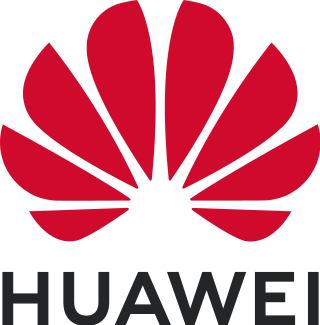
Intel Corporation is an American multinational corporation and technology company headquartered in Santa Clara, California, and incorporated in Delaware. Intel designs, manufactures and sells computer components and related products for business and consumer markets. It is considered one of the world's largest semiconductor chip manufacturers by revenue and ranked in the Fortune 500 list of the largest United States corporations by revenue for nearly a decade, from 2007 to 2016 fiscal years, until it was removed from the ranking in 2018. In 2020, it was reinstated and ranked 45th, being the 7th-largest technology company in the ranking.

ThinkPad is a line of business-oriented laptop computers and tablets, the early models of which were designed, developed and marketed by International Business Machines (IBM) starting in 1992. IBM sold its PC business, including laptops to Lenovo in 2005, and since 2007, all new ThinkPad models have been branded Lenovo instead. The Chinese manufacturer further developed the line, and is still selling new models in 2024.

WPS Office is an office suite for Microsoft Windows, macOS, Linux, iOS, Android, Fire OS and HarmonyOS developed by Zhuhai-based Chinese software developer company, Kingsoft. It also comes pre-installed on Fire tablets. WPS Office is made up of three primary components: WPS Writer, WPS Presentation, and WPS Spreadsheet. By 2022, WPS Office reached a number of more than 494 million monthly active users and over 1.2 billion installations.

Huawei Technologies Co., Ltd. is a Chinese multinational digital communications technology conglomerate corporation headquartered in Bantian, Longgang District, Shenzhen, Guangdong. It designs, develops, manufactures and sells telecommunications equipment, consumer electronics, smart devices and various rooftop solar products. The corporation was founded in 1987 by Ren Zhengfei, a former officer in the People's Liberation Army (PLA).

Acer Inc. is a Taiwanese multinational company that produces computer hardware and electronics, headquartered in Xizhi District, New Taipei City, Taiwan. Its products include desktop PCs, laptop PCs, tablets, servers, storage devices, virtual reality devices, displays, smartphones, televisions and peripherals, as well as gaming PCs and accessories under its Predator brand. As of 2024, Acer is the world's sixth-largest personal computer vendor by unit sales.

A tablet computer, commonly shortened to tablet, is a mobile device, typically with a mobile operating system and touchscreen display processing circuitry, and a rechargeable battery in a single, thin and flat package. Tablets, being computers, have similar capabilities, but lack some input/output (I/O) abilities that others have. Modern tablets largely resemble modern smartphones, the only differences being that tablets are relatively larger than smartphones, with screens 7 inches (18 cm) or larger, measured diagonally, and may not support access to a cellular network. Unlike laptops, tablets usually run mobile operating systems, alongside smartphones.
The Android Package with the file extension apk is the file format used by the Android operating system, and a number of other Android-based operating systems for distribution and installation of mobile apps, mobile games and middleware. A file using this format can be built from source code written in either Java or Kotlin.

ASUSTeK Computer Inc. is a Taiwanese multinational computer, phone hardware and electronics manufacturer headquartered in Beitou District, Taipei, Taiwan. Its products include desktop computers, laptops, netbooks, mobile phones, networking equipment, monitors, Wi-Fi routers, projectors, motherboards, graphics cards, optical storage, multimedia products, peripherals, wearables, servers, workstations and tablet PCs. The company is also an original equipment manufacturer (OEM).

Samsung DeX is a feature included on some high-end Samsung handheld devices that enables users to extend their device into a desktop-like experience by connecting a keyboard, mouse, and monitor. The name "DeX" is a contraction of "Desktop eXperience".

Huawei Mate, formally Huawei Ascend Mate, is a series of high-end HarmonyOS-powered phablet smartphones produced by Huawei, and is one of their flagship products along with the Pura series.

EMUI is an interface based on Android developed by Chinese technology company Huawei. Used on the company's smartphones primarily globally.

The Huawei Pura series is a line of high-end and medium-range HarmonyOS smartphones produced by Huawei. The P series was formerly marketed as part of Huawei's larger Ascend brand, and some models were called P smart.
openEuler is an open source project incubated and operated by the OpenAtom Foundation. EulerOS is a commercial Linux distribution developed by Huawei based on Red Hat Enterprise Linux to provide an operating system for server and cloud environments. Its open-source community version is known as openEuler, of which source code was released by Huawei at Gitee on December 31, 2019 that is multi-kernel based. EulerOS itself officially launched September 23, 2021 alongside to openEuler publicly on September 25, 2021.
HarmonyOS (HMOS) is a distributed operating system developed by Huawei for smartphones, tablets, smart TVs, smart watches, personal computers and other smart devices. It has a multi-kernel design with dual frameworks: the operating system selects suitable kernels from the abstraction layer in the case of devices that use diverse resources.

Alder Lake is Intel's codename for the 12th generation of Intel Core processors based on a hybrid architecture utilizing Golden Cove performance cores and Gracemont efficient cores. It is fabricated using Intel's Intel 7 process, previously referred to as Intel 10 nm Enhanced SuperFin (10ESF). The 10ESF has a 10%-15% boost in performance over the 10SF used in the mobile Tiger Lake processors. Intel officially announced 12th Gen Intel Core CPUs on October 27, 2021, mobile CPUs and non-K series desktop CPUs on January 4, 2022, Alder Lake-P and -U series on February 23, 2022, and Alder Lake-HX series on May 10, 2022.

Huawei Mobile Services (HMS) is a collection of proprietary services and high level application programming interfaces (APIs) developed by Huawei Technologies Co., Ltd. Its hub known as HMS Core serves as a toolkit for app development on Huawei devices. HMS is typically installed on Huawei devices on top of running HarmonyOS operating system, and on its earlier devices running the Android operating system with EMUI including devices already distributed with Google Mobile Services. Alongside, HMS Core Wear Engine for Android phones with lightweight based LiteOS wearable middleware app framework integration connectivity like notifications, status etc.

DevEco Studio is the official integrated development environment (IDE) for Huawei's HarmonyOS operating system, built on JetBrains' IntelliJ IDEA software and formerly Huawei's SmartAssist designed specifically for HarmonyOS development built by Huawei. It is available for download on Microsoft Windows and macOS based operating systems.
The version history of the HarmonyOS distributed operating system began with the public release of the HarmonyOS 1.0 for Honor Vision smart TVs on August 9, 2019. The first expanded commercial version of the Embedded, IoT AI, Edge computing based operating system, HarmonyOS 2.0, was released on June 2, 2021, for phones, tablets, smartwatches, smart speakers, routers, and internet of things. Beforehand, DevEco Studio, the HarmonyOS app development IDE, was released in September 2020 together with the HarmonyOS 2.0 Beta. HarmonyOS is developed by Huawei. New major releases are announced at the Huawei Developers Conference (HDC) in the fourth quarter of each year together with the first public beta version of the operating system's next major version. The next major stable version is then released in the third to fourth quarter of the following year.

OpenAtom OpenHarmony, abbreviated as OpenHarmony (OHOS) is a family of open-source distributed operating systems based on HarmonyOS derived from LiteOS, donated the L0-L2 branch source code by Huawei to the OpenAtom Foundation. Similar to HarmonyOS, the open-source distributed operating system is designed with a layered architecture, consisting of four layers from the bottom to the top: the kernel layer, system service layer, framework layer, and application layer. It is also an extensive collection of free software, which can be used as an operating system or in parts with other operating systems via Kernel Abstraction Layer subsystems.
HarmonyOS NEXT is a proprietary distributed operating system and an iteration of HarmonyOS, developed by Huawei to support only HarmonyOS native apps. The operating system is primarily aimed at software and hardware developers that deal directly with Huawei. It does not include Android's AOSP core and is incompatible with Android applications.













